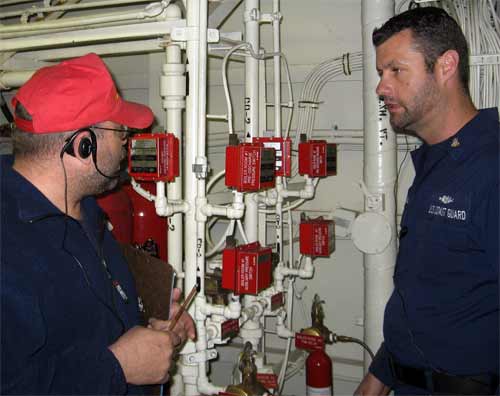First there is the disclaimer, then the alarm rings indicating a general emergency. The Crew jumps to action and the science personnel report to their designated standby stations.
I was very lucky when DCC (Damage Control Chief) George Marsden said that I could observe today's training. Three teams were involved in this specific drill: Medical, Damage Control and Engineering with approximately 10 people per team observing the actions of the crew as they responded to the reported emergency scenario.
 It is very important to prepare for any drill scenario, and make sure it doesn't turn into an actual casualty.
It is very important to prepare for any drill scenario, and make sure it doesn't turn into an actual casualty.
Our situation is a fire in the number two boiler room with a collateral injury, a crew member with a broken arm. Prior to the drill all training personnel met to discuss the risk assessment and make sure all safeties were in place so that an actual casualty would not occur. The crew knows that a drill is impending, they just don't know the specific details of this drill. The DCC and I first traveled to the CO2 room to discuss the situation with Chief Kidd who was responsible for simulating the release of the CO2 into the Boiler room compartment.
 Making sure that the release of the CO2 system is only a simulation.
Making sure that the release of the CO2 system is only a simulation.
The set up prior to the drill was that a hot work chit (notice) was placed in the engineering control center that hot work was being done in Boiler Room two. This notice set the stage for DCC Marsden who then began to set up his props for the drill, a smoke machine, identifying flags and a strobe light. All vital components in alerting the crew as to exactly what casualty they were responding to.
Finally the black smoke flag was placed in front of a shipboard closed circuit camera system and we were off. Bells and whistles, crew doing exactly as they were trained and I an active observer with a camera!
 Just one of the props used in training scenarios. This flag indicates black smoke.
Just one of the props used in training scenarios. This flag indicates black smoke.
Here are the steps to extinguishing a fire in number two boiler room. Shut off ventilation TOW first responder CO2 released Investigators set up for fire suppression team
 Similar to an initial response team,
Similar to an initial response team,
Simultaneously on the vessel, boundary compartments are checked, water tight doors closed and ALL personnel are accounted for.
Once the CO2 has been activated the fire suppression team waited fifteen minutes before entering the space, and checked the door for heat. AFFF (Aqueous Film Forming Foam) was also discharged .
Once the all clear was issued for entering the space in went the fire suppression team, with DCC Marsden and me right on their heals. I was amazed at how effective the smoke machine was, there was literally no visibility. DC2 Petty Officer Redd had a thermal imaging camera which was used as soon as they entered the space.
 Using the thermal imaging camera helps the crew members know more about the intensity of the fire.
Using the thermal imaging camera helps the crew members know more about the intensity of the fire.
Had this been an actual fire it would have taken the crew up to a day and a half to clear the space as safe. And I was fascinated to learn that in an enclosed space at around 1800° degrees a fire can actually do structural damage, which to me is terrifying. And so I say again, thank goodness the crew is trained and maintains these types of training drills so that if a casualty similar to this did occur, we would no doubt be in good hands!
 I would say that the smoke machine was pretty effective.
I would say that the smoke machine was pretty effective.
**Photo of the Day:*
 I think this picture is amazing!
I think this picture is amazing!
Quote of the Day: Man is whole when he is in tune with the winds, the stars, and the hills...Being in tune with the universe is the entire secret. -Justice William O. Douglas
FOR MY STUDENTS: Have you ever thought of a career in the U.S. Coast Guard?

